Managing soils to withstand wet winters and dry summers
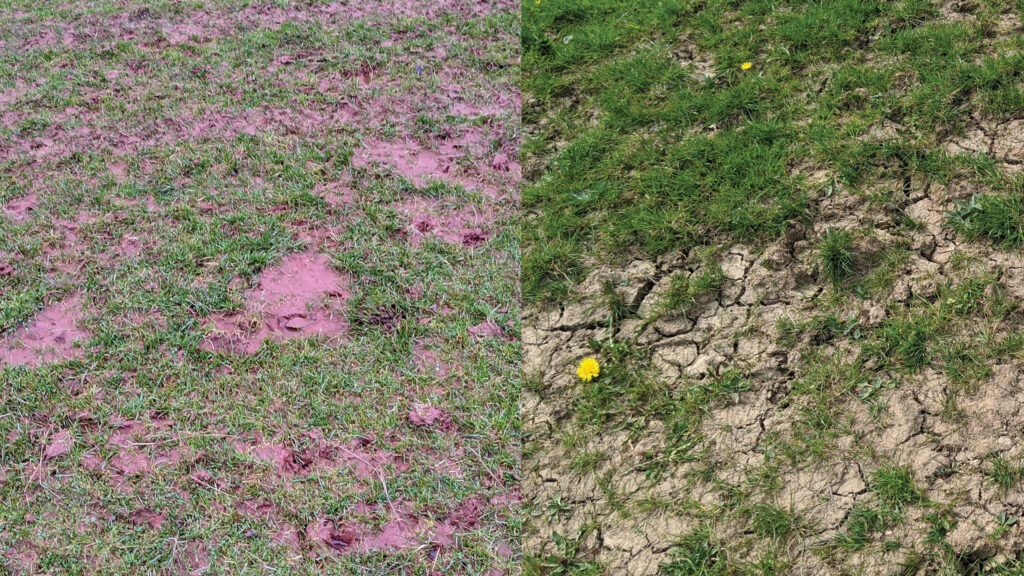 © Niels Corfield
© Niels Corfield Farmers could bolster production and farm resilience by focusing on soil health, rather than blaming the weather, soil type and location for waterlogging and drought.
So says independent farm adviser Niels Corfield, who has monitored more than 200 farms throughout the UK and believes poor soil health is holding back performance across the board.
As a result, businesses are less able to cope with extreme weather events.
See also: Why calcium is critical for soil, plant and animal health
“Poor soil health and pasture health are bringing systemic weaknesses to all farming types in all systems or situations,” he says.
“And it’s hitting the bottom line: we’re seeing shorter grazing seasons – and therefore longer housing periods and additional costs – and shorter growing seasons, lower production and burning off – basically drought.
“That is acting as a drag on stocking rates and farm incomes.”
Drought is now being seen roughly every other year, including 2020 and 2022.
Both these dry summers were preceded by wet winters, with farmers experiencing standing water and extended housing. This begs the question as to where that water went.
Infiltration
Niels says it is a misconception that standing water means soils are saturated. Often, when a hole is dug, soils are dry.
When soil infiltration rates are also assessed using an infiltration ring (see “How to monitor soil health”), typically there is no appreciable infiltration in the middle of a field over 45 minutes.
This is in contrast to water infiltrating in seconds or minutes by a hedge or fence line.
Soils also tend to appear “blocky”, with shallow rooting, in the middle of the field, but are loose and crumbly at the hedge, with a deeper and more even root mass.
Soil type is the same, so management is the only factor that could be influencing soil health, Niels says.
The attributes of the soil in the middle of the field mean water is not absorbed, leading to run-off.
Lack of infiltration has a knock-on effect in the summer, as there is no moisture to drive grass production when conditions become warm and sunny.
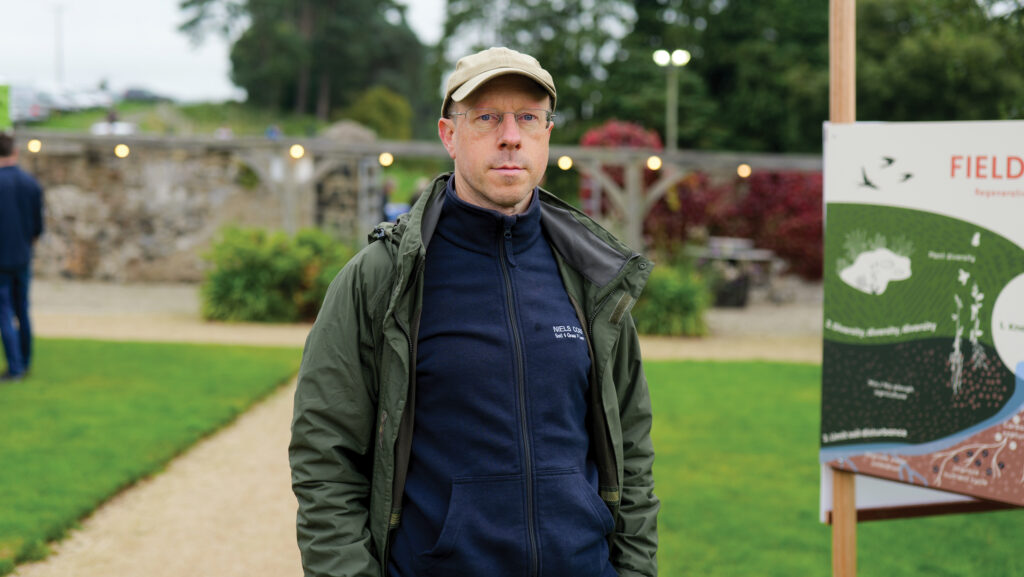
Niels Corfield © Field Good NI Conference
“Poor infiltration translates into wet ground in winter and dry ground in summer,” he explains.
By improving soil structure and infiltration, it is possible to “bank” the water that falls in winter, so the plant can draw on these reserves in the summer and drive dry matter growth.
Land that drains more freely will also extend grazing periods, leading to a shorter housing requirement.
Niels stresses there is no set formula for improving soil health and the approach will be farm specific. The key is to understand soils (see “How to monitor soil health”).
He suggests considering the following approaches:
Address grazing management
Set stocking puts grass under a constant “pruning regime”, leading to overgrazing. Stock preferentially select for the more palatable regrowth, removing the new leaf. As a result, the plant turns to its root reserve for energy, causing the roots to size down.
Rotational grazing will help boost grass production and rooting by allowing grass to rest and regrow. As a first step, split a field in half using electric fencing, group stock and move every two days.
Use diverse mixes
Reseed pasture with herbal leys. These diverse mixes will increase dry matter yields over perennial ryegrass swards. Improved sward density should also help soil health and infiltration.
Herbal leys can become gappy, so consider using a seed rate about 50% above standard. Alternatively, allow herbal leys to go to standing hay in their first year to promote in-situ over-seeding to deliver density and diversity. This works well as dry cow feed on autumn calving systems.
Using mechanical options
A roller slitter helps relieve compaction at depth, creating a shatter effect during dry conditions, post-grazing and in the shoulders of the year. A slit aerator can be used when there is less than 12.5cm of compaction, although this is unsuited to dry conditions.
Both methods can help water infiltration by opening up blocky soils and facilitate better oxygen penetration to the roots, but should not be undertaken in wet conditions.
A subsoiler can be used on most soil types during a cultivation window. Canadian research found subsoiling grassland increased infiltration by up to 10 times and yield by up to 80%. Dig soils first to check moisture and soil structure at different depths.
Flocculate soils
Soil flocculation involves particles aggregating into small clumps that water can infiltrate between. Gypsum (calcium sulphate) can help address tight soils: calcium flocculates them, while sulphur helps wash away any excess magnesium causing the tightness.
An Australian trial on arable ground found a single application of 2.5t/ha of gypsum in year one increased infiltration by 100% on sandy clay loam over four years.
Niels suggests farmers carry out a jar test to establish if gypsum could help.
- Get two jam jars and fill each one with 2.5cu cm of soil in distilled water, then shake or break up the soil so it is in suspension
- Add 2-3 pinches of gypsum (500g bags can be bought from eBay) to one jar and leave both for 24 hours
- Shake the jars up. The untreated jar will likely stay cloudy, whereas the treated jar should clear more quickly, as the clumped/flocculated soil sinks to the bottom. This shows water will drain faster as there is more internal pore space in the soil.
How to monitor soil health
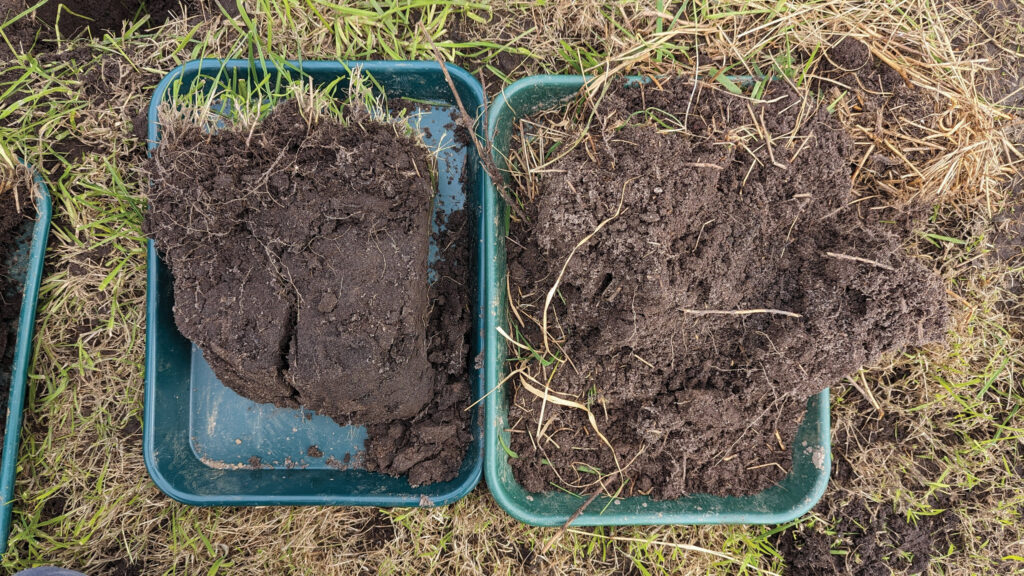
© Niels Corfield
Carry out regular spade tests comparing the middle of the field with margins/hedges
- Place spade vertical to the ground to ensure cubic shape of sample
- Insert spade, repeating on all four sides to create cube
- Lever out the whole sample
- Remove spade marks on side of cube by tearing it in half, and place this half onto a tray with the profile visible
- Look at differences between the top layer of soil and subsoil layer
- Assess the structure and aggregation of the sample
- Break up the sample to reveal the internal structure and assess blocks/crumbs
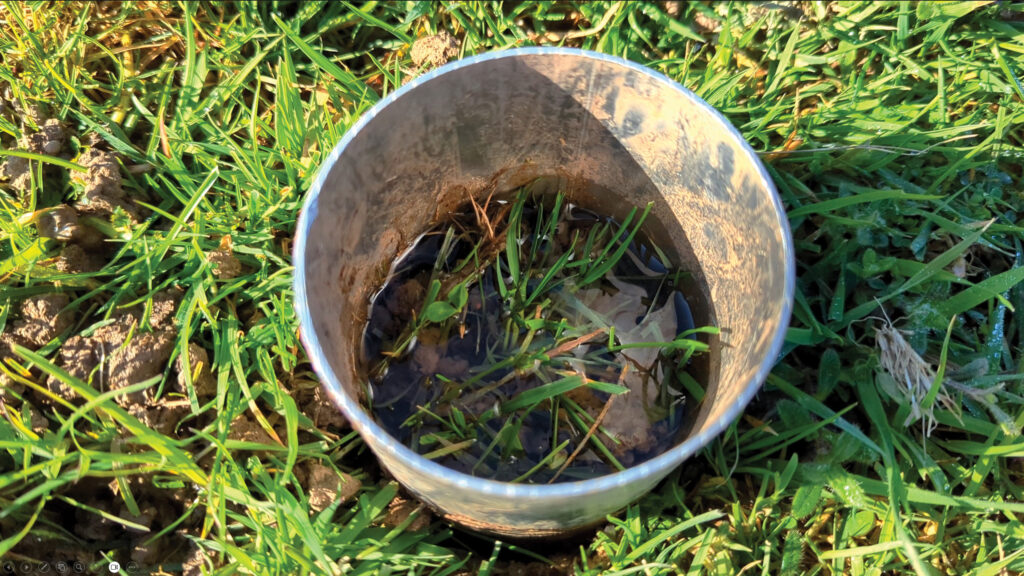
© Niels Corfield
Infiltration test with a control
Carry out an infiltration test in the centre of a field and at the hedge-line or fence (out of management) to compare the two.
Use an infiltration ring driven down to a depth of 7.5cm. Pour in 2.5cm water and time how long it takes for it to infiltrate.
Always evidence success
When making management changes, such as applying gypsum or rotational grazing, do a test strip first and then compare production, soil structure and infiltration rates against a control area.
This will give the confidence to make wider and more costly changes.
How a County Durham beef farmer is improving soil resilience
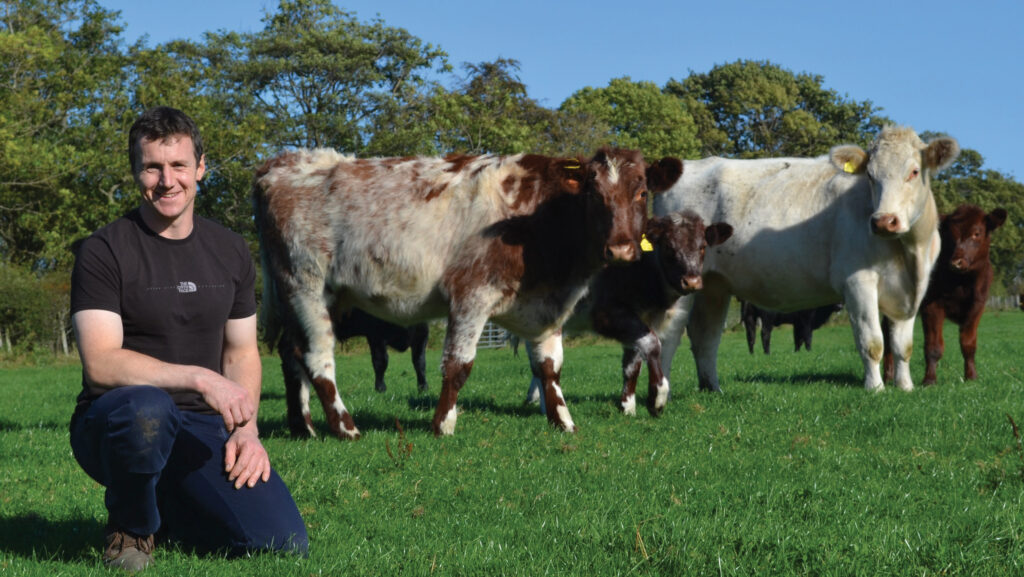
© DJ Hare
Allowing fields to rest between grazings, applying calcium lime and grazing at high stocking densities are just some of the ways Simon Hare is looking to improve the ability of his farm’s soils to cope with wet weather.
Since 2010, the business at Trees House Farm in Barnard Castle has had a complete overhaul, moving from a conventional dairy operation to an organic beef suckler herd.
“Now, it’s working with nature to look after and improve the land and produce high-quality, nutritious beef that’s all grass-based,” Simon explains.
Part of that transition has involved moving stock every day on a rotational grazing system, and resting ground for 30-70 days between grazings.
Simon believes these rest periods, when the grass can recover, replenish its energy and regrow leaf and root, are fundamental to soil health and rooting structure.
He says they have led to better rooting, less soil “blockiness”, more soil aggregates and improved infiltration rates.
This has meant soils are better able to deal with heavy rain, allowing stock to graze until late December – an average six to seven weeks longer than previously.
However, there were still some lower production fields that were prone to standing wet in the winter.
At the start of the year, independent farm adviser Niels Corfield visited the farm to assess one of the farm’s wetter fields.
When a hole was dug, the soil structure was deemed “blocky”, while water took “a long time” to drain during an infiltration test.
However, infiltration was considerably faster under a strip of trees in the middle of the field.
Following Niels’s advice, Simon decided to trial different management approaches and assess changes to soil structure over time before making wide scale investment.
He opted for the following:
Applying calcium lime
In May, calcium lime was applied at 400kg/ha along a 100m strip in the field to address soil magnesium calcium balance, which was causing soil “tightness”. This was assessed using existing soil analysis.
When a hole was dug in midsummer, Simon saw no difference between the strip and other parts of the field, but he will review again in the autumn and may apply it again next year.
Intensive grazing
Intensive grazing was trialled in July on one-third of the 6ha (15-acre) field. Some of this overlapped with the calcium lime area so soil changes could be reviewed under one or both managements.
On the intensive area, yearling and finishing cattle were stocked at the equivalent of 733 livestock units/ha with a group of 140 cattle.
These grazed for four days, with moves four times a day. Covers were entered at about 5,000kg dry matter/ha. The ground was due to be grazed intensively again in September.
This trial is likely be repeated throughout 2025 and soil structure and infiltration routinely monitored for improvements.
Farm Facts
Trees House Farm, Barnard Castle
- 162ha organic farm, all grassland
- 110 spring-calving Beef Shorthorn cows put to predominately Shorthorn bulls
- Pasture Fed Livestock Association certified: stock finished on grazed grass or grass silage
- Finishing at an average two years, grading O+ and Rs
- One-third of beef sold to local farm shop with rest to Dawn Meats
